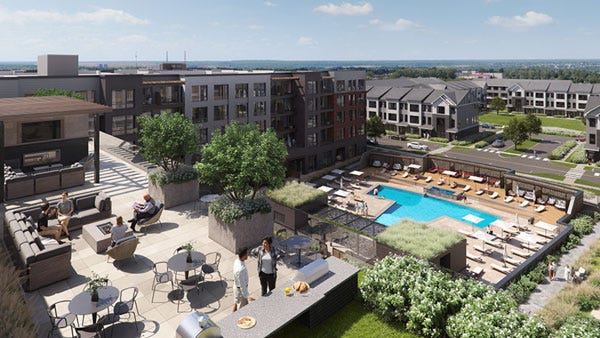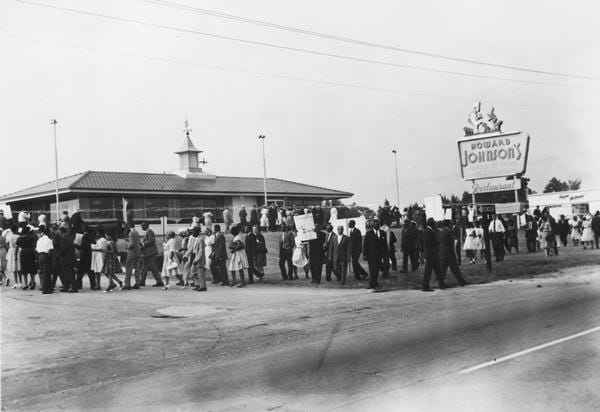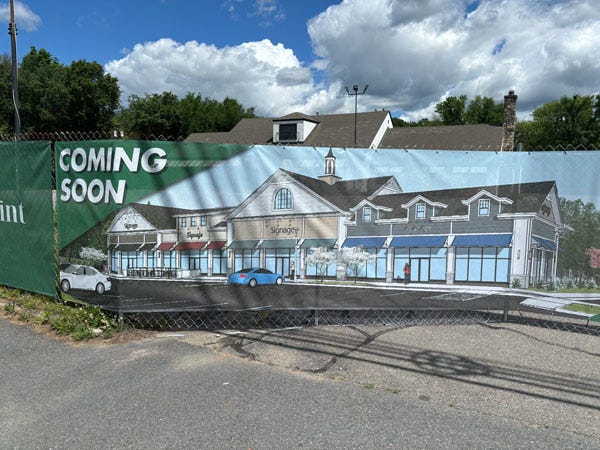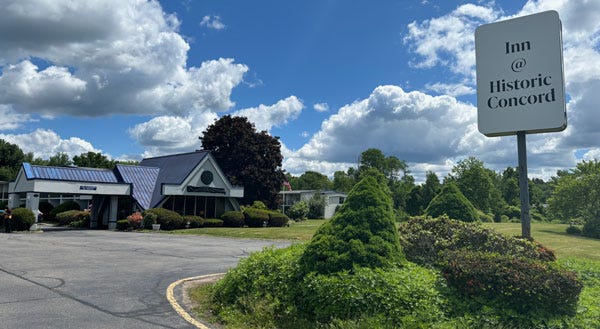Wednesday Walk: One Less HoJo
The fate of an 85 year old restaurant and what might have replaced it instead
Welcome to Willoughby Hills!
Every Wednesday, I offer a few short ideas that I hope will inspire you to do some more reading, thinking, and exploring. Let’s take a little walk together and see where the path leads…
One Less HoJo
For the last several years in this newsletter, I have grown fascinated with Howard Johnson’s, the restaurant chain that started in Massachusetts and became a beacon of midcentury roadside Americana with its iconic orange roofs.

I’ve written at length about Howard Johnson’s, while also sharing times I’ve spotted former locations on the road, from Stratford, Connecticut to Williamstown, MA. But perhaps my favorite former Howard Johnson’s is on a stretch of Route 2 in Concord, MA.
I’ve done a video tour for paying members of the Concord, MA location, which was built in 1939 and was only occupied by two restaurants in 85 years: Howard Johnson’s and the local Italian chain Papa Razzi.
Back in September, I shared the news that Papa Razzi had moved out and the fate of this site was unclear. Well, I have some sad news for folks like me that enjoy spotting vintage HoJo’s. It seems the wrecking ball is days away from this site.
The Howard Johnson’s restaurant site has been fenced off, with a new rendering for a shopping center. According to Crosspoint, the developer of the site:
“The upcoming development promises to be a vibrant hub for the Concord community, offering three new dining establishments complete with outdoor seating, alongside a regional bank equipped with a remote ATM. This mix of culinary and financial services is designed to cater to a wide range of needs, enriching the local lifestyle.”
Looking at the rendering on the fence, the argument could be made that the cupola and the dormers are an attempt at homage to Howard Johnson’s, but it also doesn’t look that different from any other small strip mall in New England. I can think of several in nearby towns built over the last decade that still sit half-vacant.
The official lineup for this development has not been announced, but according to local news reports last fall:
“One proposed restaurant could be of the ‘fast casual’ variety — not ‘fast food,’ like McDonald’s, but more on the order of Chipotle or Five Guys.
Meh.
On the one hand, I’ll be a little sad to see a relic of roadside Americana fade. Ironically, though, I can’t get too mad that the space is being taken over by national chains. After all, Howard Johnson’s was one of the first successful restaurant chains to franchise and reach critical mass on our highways and turnpikes. Chipotle and Five Guys, for better or worse, are the Howard Johnson’s of this era.
(Side note for anyone local or visiting the area: there’s very good food just around the corner from this site in West Concord, MA. Farm fresh food from Wood’s Hill Table, Saltbox Kitchen, and Adelita, plus freshly baked breads at Nashoba Brook Bakery, and delicious prepared foods at Debra’s Natural Gourmet. Seriously, if you’re in Concord, please don’t eat at Chipotle!)
When it comes to this little strip mall, I can’t help but think about how much potential is being squandered, especially when compared to how other roadside plots are getting redeveloped to meet our current societal needs.
For the last few years, I’ve occasionally passed the former Sears store in New Brunswick, NJ while driving through the Garden State. I’ve written a fair amount about Sears in this newsletter, visiting the only remaining Sears in New England last year and publishing a photo tour. It was pretty grim.

The New Brunswick Sears site has been in the process of being redeveloped into a massive mixed use community for a few years now:
“The Raye by Vermella will rise in the location of the former Sears department store. It will consist of two mixed-use buildings with 20,000 square feet of retail and 531 market rate units in a mix of studios, one, two and three-bedroom apartment homes, some featured added den space. The community will also feature 168 townhomes and a dynamic clubhouse with amenities. The project is a JV project with Transformco and will include a 23,000 square foot retail space.”

And it’s not just a slightly taller, mixed use box replacing a big box. According to one of the renderings, there seems to be a core building with ground level retail and dining and apartments above plus outbuildings with even more housing!

This project is situated on Route 1 just off the New Jersey Turnpike. It’s near the Rutgers campus and about forty miles south of Manhattan. In short, it’s an area where building more housing (and lots of it) could be a huge advantage.
Similarly, the site in Concord, though much smaller than the Sears site, is on Route 2, a major East-West thoroughfare that runs to Boston. Imagine if instead of more national chains, we actually got more housing and national chain restaurants. Both are possible! Both are necessary. The housing need is even more urgent.
If there’s any clearer indication that housing is a desperate need in Concord, just look at the site next door to the former Howard Johnson’s restaurant. At one time, it was a Howard Johnson’s motel built in the 1960s. In 2023, it was taken over by the state of Massachusetts to serve as emergency shelter for both local families suffering from homelessness as well as recently arrived migrants and refugees.
The shelter will remain operational in the old motel, even as the restaurant site gets turned into more restaurants.
At a time where there are homeless Americans, migrants and refugees that need housing, and a climate crisis that requires us to think differently and creatively about how we build and develop every part of our cities, it’s a shame to see such opportunity squandered in Concord.
Acknowledgement
I enjoy looking back at roadside Americana and the history of our built environment, but I also think it’s worth remembering that many roadside establishments, including Howard Johnson’s, were not always accessible to all Americans.
Howard Johnson’s locations in the Southern U.S., like many businesses of the time, were segregated during the chain’s heyday. HoJos became the site of sit-ins and other protests, which led the restaurant to serve customers without discrimination starting in December, 1962.

If you missed it, I explored the topic of racism and roadside Americana in an essay this past spring.
I publish new issues every Wednesday and Sunday. Sign up to always receive the latest issue and support my work:
Other Wednesday Walks
If you’ve missed past issues of this newsletter, they are available to read here.







